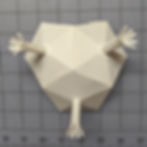Know Your Enemy
- jlalcorn
- Mar 21, 2021
- 3 min read
Updated: Mar 22, 2021

In the early days of 2020, as news of SARS-CoV-2 began to spread, images of the virus began to appear everywhere—of an almost goofy looking ball with Shrek-ear spikes poking out all over. As a visually oriented person, I was fascinated by the simplicity and seeming banality of something so potentially destructive. But then what does evil look like in nature? And to further the mystery, what is a virus, even? Is it alive? The National Human Genome Research Institute describes viruses as existing “near the boundary between the living and the nonliving.” Basically a zombie. But every form in nature is still a form of nature, and therefore a worthy subject. I decided to try to know my enemy by studying and modeling its form in paper.

My first attempts produced interesting results, but laughingly, remained flat as a pancake, refusing to form into an orb. It is axiomatic that a true sphere can not be made by folding paper, short of using something like papier machè, which is a whole different ball of...paper!
My son, Antonio, of a mathematical bent and long interested in the geometric forms of Buckminster Fuller, came to the rescue, figuring out a pattern for a structure that was a good approximation of a sphere— a stellated (pentakis) dodecahedron. A twelve-sided shape, with each of those sides having 5 raised facets, for a total of 60 facets, giving it a more rounded look than a simple dodecahedron would.
Antonio designed each section with scores to form the facets, and tabs to join each section to the next. For the spike proteins (my design contribution) we cut off the corners of each section, which provided a space for the spike protein to anchor to and poke through.

The design was created in Illustrator as vector art and then cut out on a Graphtec plotter/cutter. First we made a small model with just 3 sections to do a proof of concept. This worked, so we went on to do additional experimentation with construction techniques (what kind of tabs, what kind of adhesive, how best to attach the sections together and in what order?)
We decided upon archival white glue and double tabs for strength and precision. This meant a painstaking process of carefully applying the glue (just the right amount and not too much!) and holding the tabs together until the glue was set, first gluing all 12 sections and then adding them one by one to each other. As it went together at times it looked like a big woolly caterpillar, and as it closed up in a spiral, leaving the last section gaping open, like an alien spaceship. Both good metaphors for this mysterious, mutating, unwanted intruder.
We were very pleased with the final result—pretty satisfying. Then should we have burned it in effigy? Maybe, but it was so much work!
I later decided to make a chromatic version, printing the sections in a gradating white to blue, and with a hot red interior, like the bowels of hell, to create a contrast and feeling of hot/cold interaction. The tip of the spike proteins are the same hot red, as if the internal heat has percolated up through the spikes. I thought this model, with the “door to hell” left open might be interesting to use sculpturally, as a sort of receptacle. What might be inside? Little fortunes rolled up? Talismen or amulets? Prayers? Poems?

As I made more of the viruses and production got faster, the idea of making them to give to other artists as blank canvases to do with whatever they saw fit occurred to me. This might include artistic or ritual destruction as long the process is documented. I have yet to work out this aspect of my little coronavirus project. To be continued...
If you know the enemy and know yourself, you need not fear the result of a hundred battles. If you know yourself but not the enemy, for every victory gained you will also suffer a defeat. If you know neither the enemy nor yourself, you will succumb in every battle.
—Sun Tzu, The Art of War
Don’t fight forces, use them.
—Buckminster Fuller



















